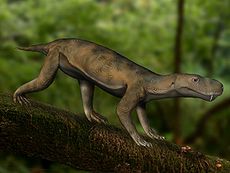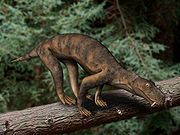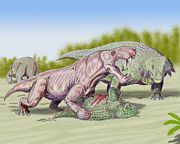- Gorgonopsia
-
Gorgonopsia
Temporal range: Middle - Late Permian
Arctognathus Scientific classification Kingdom: Animalia Phylum: Chordata Class: Synapsida Order: Therapsida Suborder: †Gorgonopsia
Seeley, 1895Family: †Gorgonopsidae
Lydekker, 1890Subfamilies Gorgonopsinae
Inostranceviinae
RubidgeinaeGorgonopsia ("Gorgon face") is a suborder of therapsid synapsids. Their name is a reference to the Gorgons of Greek mythology. Like other therapsids, gorgonopsians were at one time called "mammal-like reptiles". Their mammalian specializations include differentiated (heterodont) tooth shape, a fully developed temporal fenestra, pillar-like rear legs, a vaulted palate that may have facilitated breathing while holding the prey, and incipiently developed ear bones [1]. Gorgonopsians are a part of a group of therapsids called theriodonts, which includes mammals [2]. They were among the largest carnivores of the late Permian. The largest known, Inostrancevia, was the size of a large bear with a 45 cm long skull, and 12-cm long saber-like teeth (clearly an adaptation to being a carnivore). It is unknown whether they had fur, scales, or naked skin.
Contents
Evolutionary history
Gorgonopsids (Gorgonopsia) are theriodonts, a major group of therapsids that included the ancestors of mammals. Gorgonopsians evolved in the Middle Permian, from a reptile-like therapsid that also lived in that period. The early gorgonopsians were small, being no larger than a dog. The extinction of dinocephalians (who dominated the Middle Permian world) led the gorgonopsians to be the dominant predators of the Late Permian. Some had approached the size of a rhinoceros, such as Inostrancevia, the largest of the gorgonopsians. A nearly complete fossil of Rubidgea has been found in South Africa.[3][4] The Gorgonopsia became extinct at the end of the Permian period, being the only theriodont line to be terminated by this mass extinction.
Classification
The gorgonopsians are one of the three groups of theriodonts (the other two were the therocephalians, and the cynodonts). Theriodonts are related to the herbivorous Anomodontia. Gorgonopsia includes three subfamilies, the Gorgonopsinae, Rubidgeinae and Inostranceviinae, plus a larger number of genera that have not been placed in any of these groups. A total of 25 genera and 41 species, with the genera described most completely being Dinogorgon, Inostrancevia and Rubidgea.
The most comprehensive review of the group is by Sigogneau-Russell, 1989. However, there has not been a detailed cladistic assessment of the phylogeny of these animals.
- Order Therapsida
- SUBORDER GORGONOPSIA
- Family Gorgonopsidae
- Aelurognathus
- Aelurosaurus
- Aloposaurus
- Arctognathus
- Arctops
- Broomisaurus
- Cephalicustriodus
- Cerdorhinus
- Clelandina
- Cyonosaurus
- Dinogorgon
- Eoarctops
- Galesuchus
- Leontocephalus
- Lycaenops
- Paragalerhinus
- Scylacognathus
- Sycosaurus
- Viatkogorgon
- Subfamily Gorgonopsinae
- Subfamily Inostranceviinae
- Subfamily Rubidgeinae
- Family Gorgonopsidae
Notes
- ^ Laurin, M. (1998). New data on the cranial anatomy of Lycaenops (Synapsida, Gorgonopsidae), and reflections on the possible presence of streptostyly in gorgonopsians, Journal of Vertebrate Paleontology 18: 765-776.
- ^ Amson, E., Laurin, M. (2011). On the affinities of Tetraceratops insignis, an Early Permian synapsid, Acta Palaeontologica Polonica 56: 301–312.
- ^ First complete fossil of fierce prehistoric predator found in South Africa
- ^ ANCIENT TERROR OF EARTH'S PAST UNEARTH IN SOUTH AFRICA
References
- Bakker, R.T. (1986), The Dinosaur Heresies, Kensington Publishing Corp.
- Cox, B. and Savage, R.J.G. and Gardiner, B. and Harrison, C. and Palmer, D. (1988) The Marshall illustrated encyclopedia of dinosaurs & prehistoric animals, 2nd Edition, Marshall Publishing.
- Fenton, C.L. and Fenton, M.A. (1958) The Fossil Book, Doubleday Publishing.
- Hore, P.M. (2005), The Dinosaur Age, Issue #18. National Dinosaur Museum.
- Sigogneau-Russell, D., 1989, "Theriodontia I - Phthinosuchia, Biarmosuchia, Eotitanosuchia, Gorgonopsia" Part 17 B I, Encyclopedia of Paleoherpetology, Gustav Fischer Verlag, Stuttgart and New York.
- Ward, P.D. (2004), Gorgon, Viking Penguin.
- Gebauer (2007), Phylogeny and Evolution of the Gorgonopsia with a Special Reference to the Skull and Skeleton of GPIT/RE/7113 (‘Aelurognathus?’ parringtoni). Ph.D. Dissertation, Tübingen University.
See also
Categories:
Wikimedia Foundation. 2010.





